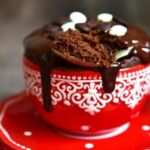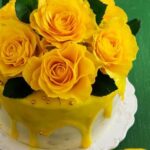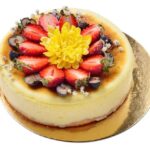Are you a beginner looking to learn how to decorate a cake with butter icing? Look no further. In this article, we will guide you through the art of creating beautifully decorated cakes using butter icing. From essential tools and ingredients to mastering basic techniques and troubleshooting common issues, we’ve got you covered. Whether it’s for a special occasion or just for fun, decorating a cake with butter icing can be an enjoyable and rewarding experience.
Before we dive into the step-by-step process of decorating cakes with butter icing, it’s important to gather all the essential tools and ingredients that you’ll need as a beginner. We’ll discuss everything from selecting the right piping tips to choosing the best food coloring and flavoring options for your butter icing. With these basics in hand, you’ll be well-equipped to embark on your journey into the world of cake decorating.
Once you have your tools and ingredients ready, it’s time to prepare the cake for decoration. We’ll share some useful tips to ensure that your cake serves as the perfect canvas for your butter icing creations. Whether you’re working with a homemade cake or store-bought, there are simple steps you can take to ensure a smooth and even surface for decorating. So let’s get started on this sweet adventure.
Getting Started
When it comes to decorating cakes with butter icing, having the right tools and ingredients is essential for beginners. Before you begin your cake decorating journey, it’s important to gather the necessary items to ensure a smooth and enjoyable experience.
Essential Tools
First and foremost, you will need a good quality offset spatula for spreading the butter icing onto the cake. This tool will help you achieve smooth and even layers of icing. Additionally, having a revolving cake stand can make the icing process much easier, as it allows you to spin the cake as you decorate. Piping bags and various tips are also essential for creating intricate designs and patterns on your cakes.
Key Ingredients
As a beginner, it’s important to start with a simple buttercream icing recipe. You will need unsalted butter, powdered sugar, vanilla extract, and a pinch of salt. These basic ingredients will create a delicious and easy-to-work-with butter icing that is perfect for beginners.
Other Supplies
In addition to tools and ingredients, having parchment paper or wax paper on hand can be helpful when preparing your workspace or practicing piping techniques before decorating your cake. It’s also useful to have food coloring gels or liquid food coloring if you plan on adding color to your butter icing.
By ensuring that you have these essential tools, ingredients, and supplies on hand before you begin decorating your cake with butter icing, you’ll set yourself up for success as a beginner in the world of cake decoration. With the right equipment and materials at your disposal, you’ll be ready to move on to the next step in creating beautifully decorated cakes.
Preparing the Cake
Decorating a cake with butter icing can be an enjoyable and creative process, but ensuring that your cake is the perfect canvas is essential for a successful decorating experience. Here are some tips to help you prepare your cake before applying butter icing:
- Choose the right type of cake: Not all cakes are suitable for butter icing. It’s important to select a cake with a firm texture, such as pound cake or sponge cake, as they provide a solid foundation for the icing.
- Leveling the cake: Before applying any butter icing, it’s crucial to ensure that your cake is level. Use a serrated knife or a cake leveler to trim off any domed top and create a flat surface. This will prevent your icing from sliding off and ensure an even layer across the entire surface.
- Crumb coat: Applying a thin layer of butter icing, known as a crumb coat, can help seal in any loose crumbs on the surface of the cake. This step is especially important if you’re working with a particularly crumbly cake. Allow the crumb coat to set before adding another layer of butter icing for a smooth finish.
By following these tips for preparing your cake, you’ll be well on your way to creating a flawless canvas for your butter icing decoration. Remember that practice makes perfect, so don’t be discouraged if it doesn’t turn out perfectly on your first attempt. Keep experimenting and refining your techniques to achieve beautiful results.
Basic Butter Icing Techniques
Before you start decorating your cake with butter icing, it’s important to master the basics of creating and applying this key element. The first step is to make sure you have the right consistency for your butter icing. It should be smooth and easy to spread, but not too runny. If it’s too thick, add a teaspoon of milk at a time until you reach the desired texture.
Once you have the right consistency, it’s time to practice your spreading technique. Using an offset spatula or a butter knife, gently spread a layer of butter icing onto your cake, making sure to cover the top and sides evenly. This will provide a smooth base for any additional decorations or piping.
After mastering the art of spreading butter icing, beginner decorators can start experimenting with different piping techniques. You can use a piping bag and various tips to create borders, swirls, flowers, and other intricate designs. Practice on parchment paper or a plate before trying out your designs on the cake itself.
| Basic Butter Icing Techniques | Step-by-Step Guide |
|---|---|
| Right Consistency | Smooth and easy to spread |
| Spreading Technique | Evenly cover top and sides |
| Piping Techniques | Create borders, swirls, flowers |
As with any new skill, practice makes perfect when it comes to mastering basic butter icing techniques. Don’t be discouraged if your first attempts are less than perfect – with time and patience, you’ll soon be creating beautifully decorated cakes that are sure to impress friends and family alike. Keep experimenting with different designs and color combinations to develop your own unique style.
Adding Color and Flavors
Here are some creative ideas for adding color and flavors to your butter icing:
- Gel Food Coloring: Gel food coloring is preferred over liquid food coloring as it doesn’t water down the consistency of the butter icing. Start with a small amount and gradually add more until you achieve your desired color.
- Natural Flavor Extracts: Experiment with different natural extracts such as vanilla, almond, lemon, or peppermint to add unique flavors to your butter icing. Be sure to start with just a small amount and taste as you go to avoid overpowering the icing.
- Fresh Fruit Purees: For a natural and fruity flavor, consider adding fresh fruit purees such as strawberries, raspberries, or passionfruit to your butter icing. Simply blend the fruit until smooth and then mix it into the icing for a burst of flavor and natural color.
Incorporating these creative additions into your butter icing can take your cake decorating skills to the next level. Don’t be afraid to experiment with different combinations of colors and flavors to create stunning and delicious masterpieces. Remember that practice makes perfect, so have fun and enjoy the process of customizing your butter icing for all of your cake decorating needs.
Piping and Decorating
Choosing the Right Piping Tips
When it comes to decorating cakes with butter icing, choosing the right piping tips can make a significant difference in the outcome of your design. For beginners, it’s recommended to start with basic tips such as round, star, and leaf tips. These are versatile and easy to work with, allowing you to create simple but elegant designs on your cake.
Techniques for Creating Beautiful Designs
Once you have selected the piping tips for your design, it’s time to explore different techniques for creating beautiful designs on your cake. The classic rosettes, swirls, and dots are great starting points for beginners. Practice steady pressure and consistent movement to achieve smooth and evenly shaped decorations. You can also experiment with more advanced techniques like ruffles, lace patterns, and basketweave designs as you gain confidence in your skills.
Adding Dimension and Texture
To add dimension and texture to your butter icing decorations, consider incorporating different piping techniques such as layering colors or using a variety of tips to create intricate details. This can elevate the overall look of your cake and make your designs stand out. Don’t be afraid to experiment with different combinations of piping tips and movements to achieve unique textures and patterns that suit the theme or occasion of your cake.
As you continue practicing these techniques for creating beautiful designs with butter icing, remember that patience and perseverance are key. With time and dedication, you’ll be able to master the art of decorating cakes with stunning butter icing designs that will impress everyone who lays eyes on them.
Troubleshooting
Decorating a cake with butter icing can be a rewarding experience, but it’s not without its challenges. As a beginner, you may encounter some common issues when working with butter icing. One of the most common problems is air bubbles in the icing, which can cause an uneven and unappealing finish.
To fix this issue, gently tap the side of the cake with a spatula to release any trapped air. You can also use a toothpick to carefully pop any small air bubbles on the surface of the icing.
Another issue that beginners often face is runny or too-soft butter icing. This can be caused by using warm ingredients or over-mixing the icing. To fix this problem, you can try refrigerating the icing for a short period of time to firm it up. If the icing is still too soft after refrigeration, you can gradually add more powdered sugar until you reach the desired consistency.
Additionally, if your butter icing becomes grainy or lumpy, it may be due to using cold ingredients or adding too much liquid at once. To remedy this issue, place the bowl of frosting over a pot of simmering water and stir until smooth. If the lumps persist, consider straining the icing through a fine-mesh sieve to remove any remaining lumps before continuing with your decorating process.
Final Touches
Once you have successfully decorated your cake with butter icing, it’s essential to consider how you will present and store it. The way you display your cake can elevate the overall presentation and make it even more appealing. When presenting your cake, consider using a decorative cake stand or platter that complements the design of your cake. This will not only showcase your beautiful creation but also add to the visual appeal.
When it comes to storing your decorated cake, proper storage is crucial to maintain its freshness and appearance. If the weather is hot or humid, it’s best to refrigerate the cake to prevent the butter icing from melting. However, if you do refrigerate the cake, be sure to allow it to come to room temperature before serving to ensure the best taste and texture.
Another important aspect of presenting and storing a decorated cake is how it is packaged if you are transporting it. Use a sturdy box or container that provides ample support and protection for the decorations on the cake. It’s also a good idea to include a non-slip mat or material in the base of the container to prevent movement during transportation.
| Presenting Tips | Storing Tips |
|---|---|
| Use a decorative cake stand or platter | Refrigerate in hot or humid weather |
| Consider packaging for transportation | Allow cakes to come to room temperature before serving |
Conclusion
In conclusion, decorating cakes with butter icing is a fun and rewarding skill to learn, and it’s important for beginners to remember that practice makes perfect. While it may seem daunting at first, with the right tools, ingredients, and techniques, anyone can create beautifully decorated cakes. It’s essential to start with the basics, such as preparing the cake properly and mastering simple butter icing techniques before moving on to more advanced designs.
As beginners continue to practice and experiment with different butter icing techniques, it’s important for them to not be discouraged by any mishaps or mistakes along the way. Troubleshooting common issues and learning how to fix them will only make them better decorators in the long run. With patience and dedication, they will eventually develop their own unique style and be able to create stunning cakes that are sure to impress friends and family.
Lastly, it’s crucial for beginners to have fun with their decorating journey. Adding color and flavors, experimenting with piping and designs, and presenting their beautifully decorated cakes can bring joy and satisfaction. So don’t be afraid to get creative and try new things – the world of cake decorating is full of endless possibilities. With perseverance and a willingness to learn, there’s no telling what amazing creations beginners can come up with using butter icing techniques.
Frequently Asked Questions
How Do You Make Butter Icing Stick to Cake?
To make butter icing stick to a cake, it’s important to ensure that the cake is completely cooled before applying the icing. You can also lightly brush the cake with a simple syrup or sugar water solution to create a sticky surface for the icing to adhere to.
It’s also helpful to chill the cake in the refrigerator for a short time after applying a thin layer of icing, as this will help the subsequent layers stick better.
How Do You Cover a Cake With Buttercream for Beginners?
For beginners, covering a cake with buttercream can seem daunting, but it’s actually quite simple with a few key steps. First, apply a thin layer of buttercream, known as a crumb coat, and refrigerate it until firm.
This will lock in any loose crumbs and create a smooth base for the final layer of buttercream. Once the crumb coat is set, apply another thicker layer of buttercream and use an offset spatula or bench scraper to smooth and level the frosting around the sides and on top of the cake.
How Far in Advance Can You Decorate a Cake With Buttercream?
You can decorate a cake with buttercream up to 2-3 days in advance if stored properly. After decorating, place the cake in an airtight container and store it in the refrigerator.
However, it’s important to note that some colors or decorations made from buttercream may fade or lose their freshness over time, so it’s best to add any delicate decorations closer to when you plan on serving the cake.

Welcome to my blog about home and family. This blog is a place where I will share my thoughts, ideas, and experiences related to these important topics. I am a stay-at-home mom with two young children. I hope you enjoy reading it! and may find some helpful tips and ideas that will make your home and family life even better!





